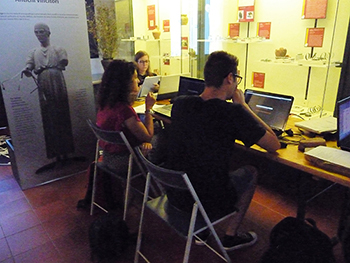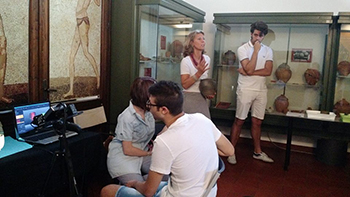MAKARS SUMMER SCHOOL VOL.II
THE FIRST TRAINING COURSE FOR DIGITAL FABRICATION AND CULTURAL HERITAGE IN VENETO REGION
Makars Summer School second and third day were spent again inside Museo di Storia Naturale e Archeologia di Montebelluna (TV) . The management has kindly prepared a working station inside the Archaelogy rooms where students could immediately elaborate with 3DFlow Zephyr software, the data they have just gathered.
We have started with Photogrammetry, the process of create a 3D model staring from bi-dimensional pictures.
3D model creation happens in 3 steps:
1- Matching: the software identifies some well recognizable key points inside at least three pictures taken allowing to create correspondences with all remaining images, connecting them among themselves and determining, for each picture the position where it was taken.
2- Mesh creation: starting from detected points, the software fills the surface with polygons, creating, what we call Mesh in the world of three-dimensional images.
3- Texture creation: when detected colors are applied to our model.
And here it is the 3D model of the Most Serene Republic of Venice’s lion, from a marble slab, property of the Museum!
To fully experience the atmosphere of the Museum, we have been able to witness the opening of one of the Museum windows for the retrieval of an archaeological find.
Our trainer Giulio Bigliardi from 3D Archeo Lab, then introduced us to 3D scanning with a light-structured 3D scanner. We have used a low-cost solution like Scan in a box.
However, before starting to scan smaller archaeological finds, Museum Curator Emanuela Gilli provided us proper indications on how to handle ancient artifacts, highlighting the importance to leave the site responsible moving them, especially extremely delicate ones.
Light structured 3D scanning is carried out through a video-camera relief of deformations of a grid projected on an object. Le procedure is carried out on all sides of the object to get a 360° scan. It is a simple and efficient way to scan small or medium objects.
By the way, we found out that not everything can be 3D scanned.
For example metal or very shiny, transparent or dark objects may be difficult to scan and we had to give up the scan of a precious glass balsamar.
With the scanner managing software it is possible to align scans one after the other, having at least 3 points of each scan corresponding to the next, until the entire 3D model or mesh is obtained.
Once we get the mesh, it is possible to proceed with texture creation, applying to the 3D model the colors which have been detected by the scanner.
In two days, we were able to 3D scan a good number of small, medium and large archeological finds and artefacts from the Museum of Montebelluna. The files are then ready for final cleaning, online loading and preparation for 3D printing.
Follow us next week to see how we did it!










